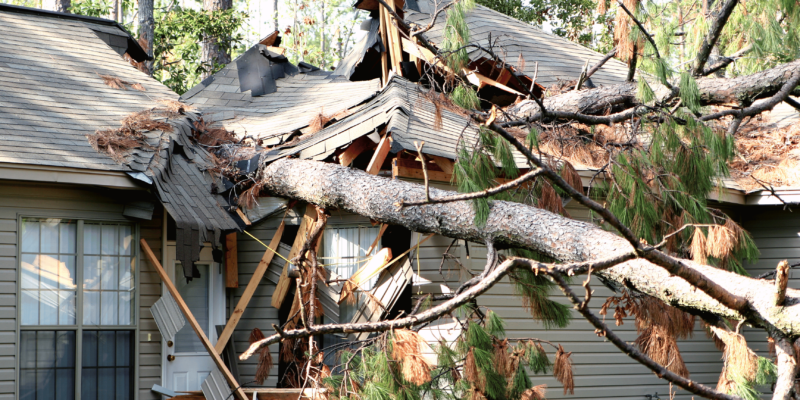Hurricane Helene first made landfall in late September 2024, quickly sweeping through communities in multiple states and leaving a trail of devastation in its path. The storm’s destructive power impacted homes, businesses, and infrastructure – forcing local communities to face the daunting task of rebuilding. While their immediate focus is on recovery, this is also an opportunity to rethink how to approach construction with an emphasis on creating structures that are better equipped to withstand natural disasters.
The Immediate Effects of Hurricane Helene
Hurricane Helene brought with it strong winds, torrential rain, and severe flooding, leaving many communities struggling to recover. Some of the most immediate and visible effects include:
Damage to Homes: Many homes have been severely damaged or completely destroyed due to the storm. Roofs have been torn off, walls collapsed, and flooding has rendered entire neighborhoods uninhabitable. Families are displaced, and temporary housing solutions are in high demand.
Infrastructure Destruction: Roads, bridges, and utility lines have been significantly impacted. Washed-out roads and collapsed bridges hindered rescue efforts and the distribution of aid. Power outages are widespread, and water systems have been compromised due to flooding and contamination, leaving thousands without potable water.
Business Closures: Many local businesses, from small shops to larger establishments, have suffered extensive damage. Buildings have been destroyed or flooded, leaving owners without a means of income and employees without jobs.
Agriculture and Food Supply: Helene’s storm surge inundated farmlands, damaging crops and disrupting local food supplies. This could lead to shortages and increased costs in the weeks and months ahead, compounding the challenges for communities already facing hardship.
The Impact on Construction
As the cleanup process begins, it’s clear that large-scale reconstruction efforts will be necessary. Some of the key areas of focus include:
Residential Housing: Thousands of homes will need to be rebuilt or repaired, particularly in areas where flooding or wind damage was severe. This presents a unique opportunity to build stronger, more resilient homes that can withstand future hurricanes.
Infrastructure: Roads, bridges, and utility lines will need to be rebuilt to ensure communities are reconnected. Stronger materials and innovative designs have the potential to prevent the kind of widespread destruction seen in Helene’s path.
Public Facilities: Schools, hospitals, and other public buildings that serve as shelters during storms will need to be fortified. Rebuilding these structures with disaster resilience in mind is crucial for ensuring the safety and well-being of communities in the future.
Coastal Defenses: Coastal areas that suffered from storm surges may need enhanced barriers or levees to protect against future flooding. Rebuilding natural barriers, like wetlands and dunes, could also serve as a first line of defense against rising sea levels and storm surges.
Rebuilding for the Future: Stronger and More Resilient
While the devastation caused by hurricanes and tropical storms is profound, the reconstruction process offers a chance to build smarter and more resilient structures.
Here’s how communities can approach rebuilding with long-term sustainability in mind:
Stronger Building Materials: Using materials like hurricane-resistant windows, reinforced concrete, and steel framing can improve a building’s ability to withstand high winds and heavy rain. These materials are designed to reduce structural damage and increase the lifespan of buildings in disaster-prone areas.
Elevating Structures: In areas prone to flooding, elevating homes and buildings above flood levels can be a crucial measure. This technique reduces the risk of water damage and can help protect homes and businesses from future storms.
Implementing Building Codes: Strict building codes tailored to withstand natural disasters should be enforced in the reconstruction process. These codes can ensure that buildings are constructed to survive hurricanes, floods, and other natural disasters.
Green Infrastructure: Rebuilding with sustainability in mind can provide long-term benefits. Green roofs, permeable pavements, and water retention systems can help manage stormwater and reduce flooding. Restoring natural ecosystems, such as wetlands, can also mitigate the effects of hurricanes by absorbing storm surge and reducing erosion.
Disaster-Resilient Infrastructure Design: Infrastructure like roads and bridges can be designed to withstand the stresses of future storms. Elevated roadways, flexible materials that can withstand wind, and better drainage systems will ensure that these critical systems stay intact during natural disasters.
Energy Resilience: Rebuilding efforts should also focus on energy resilience. Installing microgrids, solar panels, and other renewable energy sources can help communities remain powered even when the main grid is down. This not only increases sustainability but also provides a critical lifeline during emergencies.
Our hearts are with the many people who lost friends and family members to Hurricane Helene, and to the survivors who are working together to recover their homes and livelihoods. We hope that these communities are provided with the opportunity to focus on disaster-resilient construction methods, stronger building codes, and sustainable infrastructure, so that they can not only recover, but emerge stronger and better prepared for future natural disasters.

